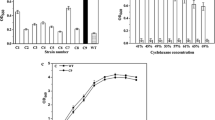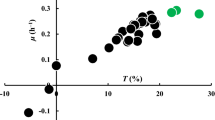Abstract
Microbial tolerance to organic solvents is critical for efficient production of biofuels. In this study, n-butanol tolerance of Escherichia coli JM109 was improved by overexpressing of genes encoding stress-responsive small RNA-regulator, RNA chaperone, and molecular chaperone. Gene rpoS, coding for sigma S subunit of RNA polymerase, was the most efficient in improving n-butanol tolerance of E. coli. The highest OD600 and the specific growth rate of JM109/pQE80L-rpoS reached 1.692 and 0.144 h–1 respectively at 1.0% (v/v) n-butanol. Double and triple expression of molecular chaperones rpoS, secB, and groS were conducted and optimized. Recombinant strains JM109/pQE80L-secB-rpoS and JM109/pQE80L-groS-secB-rpoS exhibited the highest n-butanol tolerance, with specific growth rates of 0.164 and 0.165 h–1, respectively. Membrane integrity, potentials, and cell morphology analyses demonstrated the high viability of JM109/pQE80L-groS-secB-rpoS. This study provides guidance on employing various molecular chaperones for enhancing the tolerance of E. coli against n-butanol.






Similar content being viewed by others
References
Mariano, A. P., Tomasella, R. C., Martino, C. D., Maciel, R., Seleghim, M. H. R., & Contiero, J. (2016). Aerobic biodegradation of butanol and gasoline blends. Biomass and Bioenergy, 33, 1175–1181.
Jeon, J. M., Song, H. S., Lee, D. G., Hong, J. W., Hong, Y. G., Moon, Y. M., Bhatia, S. K., Yoon, J. J., Kim, W., & Yang, Y. H. (2018). Butyrate-based n-butanol production from an engineered Shewanella oneidensis MR-1. Bioprocess and Biosystems Engineering, 41, 1195–1204.
Chin, W. C., Lin, K. H., Liu, C. C., & Kenji, T. (2017). Improved n-butanol production via co-expression of membrane-targeted tilapia metallothionein and the clostridial metabolic pathway in Escherichia coli. BMC Biotechnology, 17, 36.
Chen, X., Zhou, L., Kangming, T., Kumar, A., & Wang, Z. (2013). Metabolic engineering of Escherichia coli: a sustainable industrial platform for bio-based chemical production. Biotechnology Advances, 31, 1200–1223.
Cano-Garrido, O., Sanchez-Chardi, A., Pares, S., Giro, I., Tatkiewicz, W. I., Ferrer-Miralles, N., Ratera, I., Natalello, A., Cubarsi, R., Veciana, J., Bach, A., Villaverde, A., Aris, A., & Garcia-Fruitos, E. (2016). Functional protein-based nanomaterial produced in microorganisms recognized as safe: a new platform for biotechnology. Acta Biomaterialia, 43, 230–239.
Cho, C., & Lee, S. Y. (2017). Efficient gene knockdown in Clostridium acetobutylicum by synthetic small regulatory RNAs. Biotechnology and Bioengineering, 114, 374–383.
Liu, S., Wu, Y., Wang, T., Zhang, C., & Xing, X. (2017). Maltose utilization as a novel selection strategy for continuous evolution of microbes with enhanced metabolite production. ACS Synthetic Biology, 6, 2326–2338.
Abil, Z., Ellefson, J. W., Gollihar, J. D., Watkins, E., & Ellington, A. D. (2017). Compartmentalized partnered replication for the directed evolution of genetic parts and circuits. Nature Protocols, 12, 2493–2512.
Knoshaug, E. P., & Zhang, M. (2009). Butanol tolerance in a selection of microorganisms. Applied Biochemistry and Biotechnology, 153, 13–20.
Yang, D. C., Tian, D. X., Xue, C., Gao, F., Liu, Y., Li, H., Bao, Y. M., Liang, J. J., Zhao, Z. B., & Qiu, J. S. (2018). Tuned fabrication of the aligned and opened CNT membrane with exceptionally high permeability and selectivity for bioalcohol recovery. Nano Letters, 18, 6150–6156.
Yang, D. C., Cheng, C., Bao, M. T., Chen, L. J., Bao, Y. M., & Xue, C. (2019). The pervaporative membrane with vertically aligned carbon nanotube nanochannel for enhancing butanol recovery. Journal of Membrane Science, 577, 51–59.
Segura, A., Lázaro, M., Fillet, S., Krell, T., Bernal, P., Muñoz-Rojas, J., & Ramos, J. L. (2012). Solvent tolerance in Gram-negative bacteria. Current Opinion in Biotechnology, 23, 415–421.
Alsaker, K. V., Paredes, C., & Papoutsakis, E. T. (2010). Metabolite stress and tolerance in the production of biofuels and chemicals: Gene-expression-based systems analysis of butanol, butyrate, and acetate stresses in the anaerobe Clostridium acetobutylicum. Biotechnology and Bioengineering, 105, 1131–1147.
Sikkema, J., Bont, J. A. D., & Poolman, B. (1995). Mechanisms of membrane toxicity of hydrocarbons. Microbiological Reviews, 59, 201–222.
Heipieper, H. J., Meinhardt, F., & Segura, A. (2003). The cis-trans isomerase of unsaturated fatty acids in Pseudomonas and Vibrio: biochemistry, molecular biology and physiological function of a unique stress adaptive mechanism. FEMS Microbiology Letters, 229, 1–7.
Pinkart, H. C., & White, D. C. (1997). Phospholipid biosynthesis and solvent tolerance in Pseudomonas putida strains. Journal of Bacteriology, 179, 4219–4226.
Ramos, J. L., Duque, E., Gallegos, M. T., & Godoy, P. (2002). Mechanism of tolerance in Gram-negative bacteria. Annual Review of Microbiology, 56, 743–768.
Rühl, J., Hein, E. M., Hayen, H., Schmid, A., & Blank, L. M. (2012). The glycerophospholipid inventory of Pseudomonas putida is conserved between strains and enables growth condition related alterations. Microbiology and Biotechnology, 5, 45–58.
Bernal, P., Segura, A., & Ramos, J. L. (2010). Compensatory role of the cis-trans-isomerase and cardiolipin synthase in the membrane fluidity of Pseudomonas putida DOT-T1E. Environmental Microbiology, 9, 1658–1664.
Segura, A., Godoy, P., & Dillewijn, P. V. (2005). Proteomic analysis reveals the participation of energy and stress-related proteins in the response of Pseudomonas putida DOT-T1E to toluene. Journal of Bacteriology, 187, 5937–5945.
Zhang, F., Qian, X. H., Si, H. M., Xu, G. C., Han, R. Z., & Ni, Y. (2015). Significantly improved solvent tolerance of Escherichia coli by global transcription machinery engineering. Microbial Cell Factories, 14, 1–11.
Daniels, C. (2010). Functional analysis of new transporters involved in stress tolerance in Pseudomonas putida DOT-T1E. Environmental Microbiology Reports, 2, 389–395.
Nikaido, H., & Takatsuka, Y. (2009). Mechanisms of RND multidrug efflux pumps. Biochimica et Biophysica Acta, 1794, 769–781.
Horinouchi, T., Tamaoka, K., Furusawa, C., Ono, N., Suzuki, S., Hirasawa, T., Yomo, T., & Shimizu, H. (2010). Transcriptome analysis of parallel-evolved Escherichia coli strains under ethanol stress. BMC Genomics, 11, 579.
Si, H. M., Zhang, F., Wu, A. N., Han, R. Z., Xu, G. C., & Ni, Y. (2016). DNA microarray of global transcription factor mutant reveals membrane-related proteins involved in n-butanol tolerance in Escherichia coli. Biotechnology for Biofuels, 9, 114.
Xu, G. C., Wu, A. N., Xiao, L., Han, R. Z., & Ni, Y. (2019). Enhancing butanol tolerance of Escherichia coli reveals hydrophobic interaction of multi-tasking chaperone SecB. Biotechnology for Biofuels, 12, 164.
Hu, J., & Wang, Q. (2018). Regulatory sRNAs in Cyanobacteria. Frontiers in Microbiology, 9, 2399.
Durand, S., Braun, F., Helfer, A. C., Romby, P., & Condon, C. (2017). sRNA-mediated activation of gene expression by inhibition of 5′-3′ exonucleolytic mRNA degradation. eLife, 6, e23602.
Zhang, Y. F., Han, K., Chandler, C. E., Tjaden, B., Ernst, R. K., & Lory, S. (2017). Probing the sRNA regulatory landscape of P. aeruginosa: post-transcriptional control of determinants of pathogenicity and antibiotic susceptibility: sRNA regulatory landscape of P. aeruginosa. Molecular Microbiology, 106, 919–937.
Morita, T., & Aiba, H. (2019). Mechanism and physiological significance of autoregulation of the Escherichia coli hfq gene. RNA, 25, 264–276.
Murashko, O. N., & Lin, C. S. (2017). Escherichia coli responds to environmental changes using enolasic degradosomes and stabilized DicF sRNA to alter cellular morphology. Proceedings of the National Academy of Sciences of the United States of America, 114, 8025–8034.
Ezemaduka, A. N., Lv, Y., Wang, Y. B., Xu, J. B., & Li, X. J. (2018). Heterologous expression of AgsA enhances, Escherichia coli, tolerance to the combined effect of elevated temperature and Zinc toxicity. Journal of Thermal Biology, 72, 137–142.
Battesti, A., Majdalani, N., & Gottesman, S. (2011). The RpoS mediated general stress response in Escherichia coli. Annual Review of Microbiology, 65, 189–213.
Zhang, R., Cao, Y., Wei, L., Xian, M., & Liu, H. Z. (2017). Improving phloroglucinol tolerance and production in Escherichia coli by GroESL overexpression. Microbial Cell Factories, 16, 227.
Zingaro, K. A., & Terry, P. E. (2013). GroESL overexpression imparts Escherichia coli tolerance to i-, n-, and 2-butanol, 1,2,4-butanetriol and ethanol with complex and unpredictable patterns. Metabolic Engineering, 15, 196–205.
Zingaro, K. A., & Eleftherios, T. P. (2012). Toward a semisynthetic stress response system to engineer microbial solvent tolerance. Mbio, 3, 429–493.
Mann, M. S., Dragovic, Z., Schirrmacher, G., & Lutkeeversloh, T. (2012). Over-expression of stress protein-encoding genes helps Clostridium acetobutylicum to rapidly adapt to butanol stress. Biotechnology Letters, 34, 1643–1649.
Hengge-Aronis, R. (2002). Signal transduction and regulatory mechanisms involved in control of the sigma (S) (RpoS) subunit of RNA polymerase. Microbiology and Molecular Biology Reviews, 66, 373–395.
Schellhorn, H. E., & Stones, V. L. (1992). Regulation of Katf and Kate in Escherichia coli K-12 by weak acids. Journal of Bacteriology, 174, 4769–4776.
Trick, H. N., & Finer, J. J. (1997). SAAT: sonication-assisted Agrobacterium-mediated transformation. Transgenic Research, 6, 329–336.
Darzynkiewicz, Z., Bruno, S., Bino, G. D., Gorczyca, W., Hotz, M. A., Lassota, P., & Traganos, F. (1992). Features of apoptotic cells measured by flow cytometry. Cytometry, 13, 795–808.
Acknowledgments
We are grateful to the National Key Research and Development Program (2018YFA0901700), the National Natural Science Foundation of China (21776112), Natural Science Foundation of Jiangsu Province (BK20171135), the national first-class discipline program of Light Industry Technology and Engineering (LITE2018-07), the Program of Introducing Talents of Discipline to Universities (111-2-06), and Top-notch Academic Programs Project of Jiangsu Higher Education Institutions for the financial support of this research.
Author information
Authors and Affiliations
Corresponding author
Ethics declarations
Conflict of Interest
The authors declare that they have no competing interests.
Additional information
Publisher’s Note
Springer Nature remains neutral with regard to jurisdictional claims in published maps and institutional affiliations.
Electronic supplementary material
ESM 1
(DOCX 27455 kb)
Rights and permissions
About this article
Cite this article
Xu, G., Xiao, L., Wu, A. et al. Enhancing n-Butanol Tolerance of Escherichia coli by Overexpressing of Stress-Responsive Molecular Chaperones. Appl Biochem Biotechnol 193, 257–270 (2021). https://doi.org/10.1007/s12010-020-03417-4
Received:
Accepted:
Published:
Issue Date:
DOI: https://doi.org/10.1007/s12010-020-03417-4




